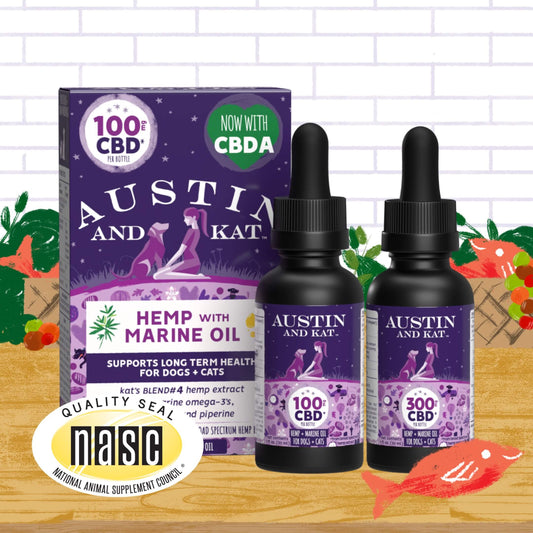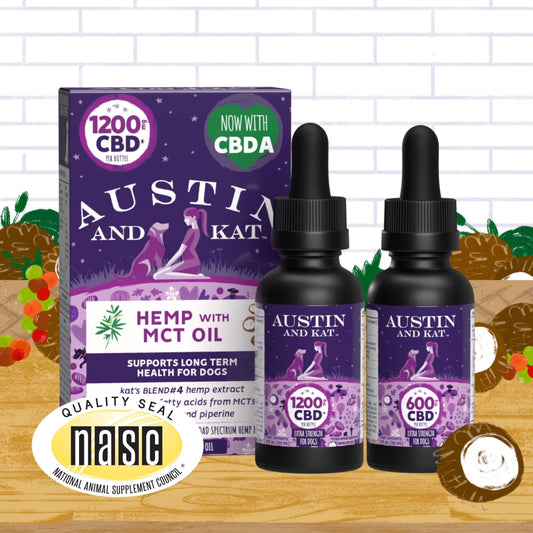
The Power of Proactive Wellness
Unlike waiting for problems to emerge, proactive wellness means supporting your dog's natural systems while they're strong and thriving. Think of it like going to the gym regularly versus only exercising when you're already out of shape—the earlier you start, the more profound and lasting the benefits.
During these prime years, your dog's body is actively building the foundation for everything that comes next. Their joints are developing the resilience they'll need for years of movement. Their nervous system is learning how to handle stress and recover from stimulation. Their immune system is calibrating its responses to daily challenges. Supporting these processes now can make the difference between a dog who ages gracefully and one who struggles with every passing year.
Adult dogs in their prime have unique needs that differ dramatically from both puppies and seniors. They're past the rapid growth phase but not yet dealing with age-related decline. This makes it the perfect time to focus on:
Balance and Stability: Adult dogs face daily stressors—from separation anxiety to overstimulation during walks—that can accumulate over time. Supporting their nervous system helps them stay emotionally balanced and mentally sharp.
Cellular Health: Every day, your dog's cells work hard to repair damage, fight inflammation, and maintain optimal function. The right nutritional support helps this process work efficiently, building resilience from the inside out.
Recovery and Adaptation: Whether it's bouncing back from a long hike, adjusting to schedule changes, or processing new experiences, adult dogs need support for healthy recovery and adaptation.

The Foundation: Daily Wellness Support
Daily wellness support works like a foundation—it provides consistent, background support that helps your dog's natural systems function at their best. When used consistently, natural supplements help dogs maintain emotional balance, support cellular health, and build resilience that compounds over time.
Why Daily Support Makes a Difference:
Cumulative Benefits: Ingredients like CBD work with your dog's endocannabinoid system to support natural balance and homeostasis. This isn't something that happens overnight—it's a gradual process where consistent support helps the body's systems work more efficiently.
Baseline Stability: Dogs thrive on routine and predictability. Daily wellness support helps establish a stable baseline, making it easier for them to handle whatever the day brings—from unexpected visitors to changes in weather.
Proactive Prevention: Rather than waiting for stress or challenges to overwhelm your dog's natural coping mechanisms, daily support helps maintain resilience before problems arise.
Building Long-term Health: The compounds in quality hemp extracts and botanical blends support cellular health, nervous system function, and natural inflammatory responses—processes that contribute to how well your dog will age.
Many pet parents choose to start daily wellness support not because their dog has specific problems, but because they want to give them the best possible foundation for lifelong health and happiness.

Targeted Situational Support
Even dogs on daily wellness routines benefit from additional support during specific situations. Adult dogs face various challenges that can temporarily overwhelm their natural coping mechanisms, and having targeted support available ensures they can handle these moments with confidence.
When Extra Support Makes the Biggest Difference:
Environmental Stressors: Thunderstorms, fireworks, construction noise, or even busy social gatherings can challenge even the most balanced dogs. Additional support during these times helps them stay calm and centered.
Routine Changes: Travel, boarding, moving homes, or changes in family schedules can disrupt your dog's sense of stability. Extra support helps them adapt more easily to new situations.
Physical Challenges: After particularly active days, during weather changes that affect joint comfort, or when recovering from minor injuries, additional support can help with comfort and recovery.
Social Situations: Dog parks, training classes, grooming appointments, or vet visits can be overstimulating for many dogs. Strategic support before these events helps them stay focused and confident.
Seasonal Adjustments: Many dogs need extra support during seasonal transitions, allergy seasons, or periods when their routine naturally shifts.

Creating an Environment for Optimal Wellness
Your dog's daily environment plays a huge role in their overall wellness. Unlike seniors who need accommodations for physical limitations, adult dogs benefit from environments that challenge them appropriately while providing security and comfort.
Physical Environment Considerations:
Space for Movement: Adult dogs need room to express natural behaviors—stretching, playing, exploring. Even apartment dogs benefit from furniture arrangements that encourage movement and interesting spatial experiences.
Mental Stimulation: Boredom is one of the biggest wellness challenges for adult dogs. Rotate toys, create food puzzles, hide treats around the house, and regularly introduce new safe experiences to keep their minds engaged.
Safe Retreat Spaces: Every dog needs a place where they can decompress and feel completely secure. This might be a crate, a specific bed, or even just a corner where they're never disturbed.
Natural Light and Fresh Air: Regular exposure to natural light helps regulate circadian rhythms, while fresh air provides important sensory stimulation and stress relief.

Exercise and Activity for Lifelong Health
Adult dogs in their prime can handle more vigorous exercise than seniors, but the goal isn't just physical exhaustion—it's building strength, coordination, and mental resilience that will serve them throughout their lives.
Varied Movement Patterns: Instead of just long walks, incorporate activities that challenge different muscle groups and movement patterns—hill walking, swimming, agility obstacles, or even controlled roughhousing.
Mental Exercise: Training sessions, puzzle-solving, and new skill development can be just as tiring as physical exercise and help build cognitive resilience.
Recovery Periods: Even young, healthy dogs need adequate rest between activities. Overexercise can actually compromise immune function and increase stress hormones.
Social Interaction: Regular, positive interactions with other dogs, people, and environments help build social confidence and emotional regulation skills.
Nutrition and Daily Routines
The foundation of any wellness strategy starts with consistent, high-quality nutrition and predictable daily routines that support your dog's natural rhythms.
Supporting Wellness Through Routine:
Consistent Meal Times: Regular feeding schedules help regulate digestion, energy levels, and even sleep patterns. Most adult dogs thrive on twice-daily feeding.
Hydration Support: Fresh, clean water should always be available, and many dogs benefit from wet food or bone broth to increase moisture intake.
Sleep Hygiene: Adult dogs need 12-14 hours of sleep per day. Creating consistent bedtime routines and protecting their sleep environment supports recovery and mental health.
Predictable Daily Structure: While variety is important, having a basic daily framework helps dogs feel secure and reduces background stress.

Understanding Different Formats and Their Benefits
Austin's Everyday Wellness collection offers multiple formats, each designed to serve different aspects of your dog's wellness routine. Understanding how these work together helps you build a comprehensive support system.
Soft Chews – Convenient Daily Foundation
Soft chews provide a convenient, pre-measured way to give daily wellness support. They're ideal for dogs who thrive on routine and for families who want the simplicity of knowing exactly how much support they're providing each day. The slow-release nature of chews makes them perfect for all-day balance and stability.
- Consistent, measurable dosing
- Easy to incorporate into daily routines
- Dogs typically love the taste and see them as treats
- Portable for travel or schedule changes
- Steady support throughout the day
CBD Oils – Flexible and Fast-Acting
CBD oils offer precise dosing control and faster onset, typically working within 20-45 minutes. This makes them ideal for situational support, dose adjustments, or dogs who need customized amounts based on their individual responses.
- Precise dose control with graduated droppers
- Faster onset for situational needs
- Easy to adjust amounts up or down
- Can be mixed with food or given directly
- Suitable for dogs with chewing difficulties
Extra Strength Options – For Larger Dogs or Higher Support Needs
Extra strength formulations provide higher concentrations for larger dogs, multi-pet families, or dogs who need additional support. These aren't necessarily "stronger"—they're more concentrated, allowing for appropriate dosing without having to give large volumes.

Creating Your Dog's Personalized Wellness Plan
The most successful wellness strategies combine consistent daily support with flexible situational adjustments. Here's how to think about building your dog's plan:
Start with Daily Foundation
Begin with a consistent daily routine that provides baseline support for your dog's nervous system, cellular health, and stress resilience. This might be:
- Daily soft chews given with breakfast
- Oil mixed into evening meals
- A combination approach using chews most days with oil for flexibility
Layer in Situational Support
Identify the situations where your dog could benefit from additional support and have a plan ready:
- Extra oil before potentially stressful events
- Additional chews during seasonal transitions
- Increased support during schedule disruptions or travel
- Higher doses during recovery from illness or injury
Monitor and Adjust
Pay attention to how your dog responds and be willing to adjust your approach:
- Track patterns in your dog's behavior and stress responses
- Note which situations require extra support
- Adjust daily amounts based on your dog's individual needs
- Consider seasonal changes that might affect requirements
Every dog is unique, and the most effective wellness strategy is one that's tailored to your dog's specific needs, personality, and lifestyle. Whether your dog is a high-energy working breed who needs help with recovery, a sensitive rescue who benefits from daily emotional support, or a social butterfly who needs extra help during overstimulating situations, the right combination of consistent daily support and flexible situational adjustments can help them thrive throughout their prime years.





















